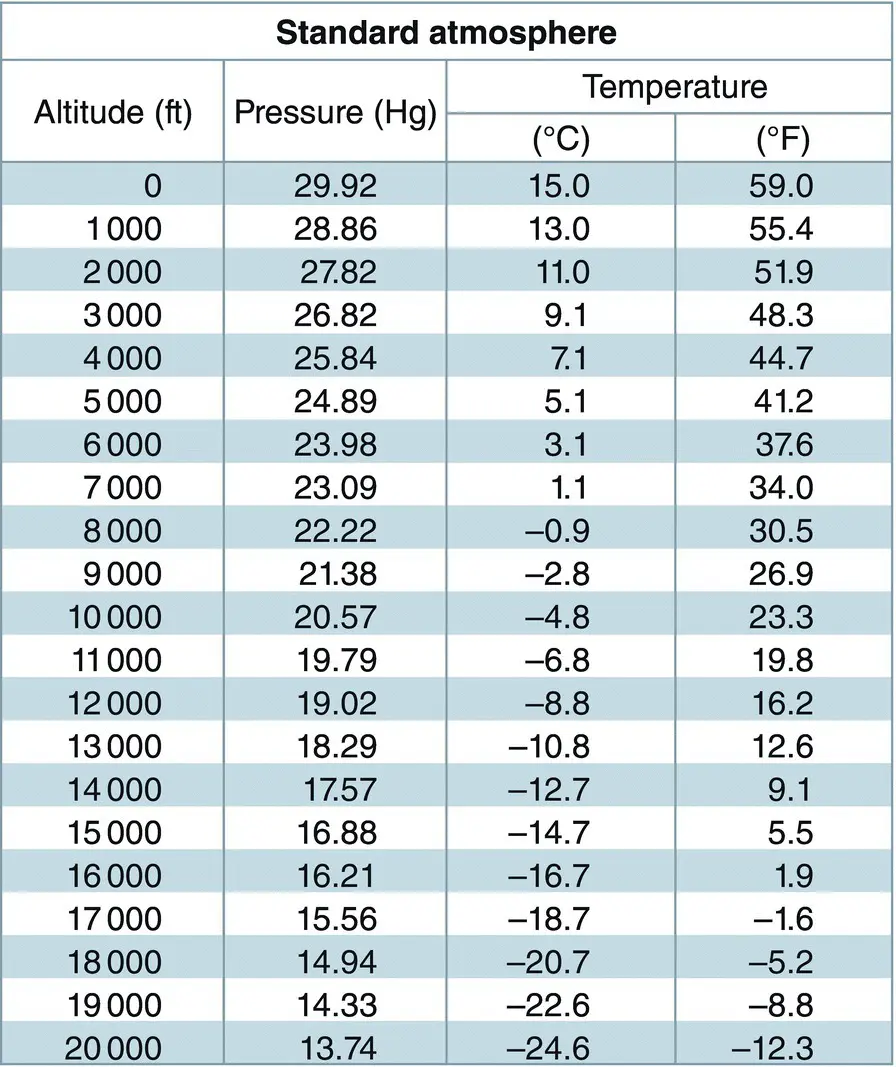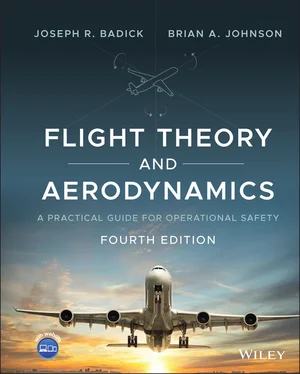1 ...8 9 10 12 13 14 ...22 
Figure 2.2 Properties of a standard atmosphere.
Source: U.S. Department of Transportation Federal Aviation Administration (2016b).
In aerodynamics, it is convenient to use pressure ratios, rather than actual pressures; thus the units of measurement are canceled out. When at sea level on a standard day, the pressure ratio can be determined using equation:
(2.1) 
where P 0is the sea level standard static pressure (2116 psf or 29.92″ Hg). Thus, a pressure ratio of 0.5 means that the ambient pressure is one‐half of the standard sea level value. At 18 000 ft, on a standard day, the pressure ratio is 0.4992.
The commonly used measures of temperature are the Fahrenheit, °F, and Celsius, °C scales. Aviation weather reports for pilots, as well as performance calculation tables, will usually report the temperature in °C. In a standard atmosphere, the sea level surface temperature is 15 °C or 59 °F.
Since neither of these scales has absolute zero as a base, neither can be used in calculations; absolute temperature must be used instead. Absolute zero is −460 °F, or −273 °C. To convert from the Fahrenheit system to the absolute system, called Rankine, R, add 460 to the °F. To convert from the Celsius system to the absolute system, called Kelvin, K, add 273 to the °C. The symbol for absolute temperature is T and the symbol for sea level standard temperature is T 0:

By using temperature ratios, instead of actual temperatures, the units cancel. The temperature ratio is the Greek letter theta, θ :
(2.2) 
At sea level, on a standard day, θ 0°= 1.0. Temperature in a standard atmosphere decreases with altitude until the tropopause is reached (36 089 ft on a standard day). The rate of change of temperature with altitude is known as the lapse rate. The standard lapse rate is approximately a 2 °C decrease in temperature for every 1000 ft increase in altitude from sea level ( Figure 2.2) up to the tropopause. Temperature then remains constant until an altitude of about 82 023 ft.
As an example, if the temperature at the tropopause is −69.7 °F, calculate θ :

Density is the most important property of air in the study of aerodynamics, and is directly impacted by pressure, temperature, and humidity changes. Since air can be compressed and expanded, the lower the pressure the less dense the air: density is directly proportional to pressure. Increasing the temperature of the air (giving the particles greater kinetic energy) also decreases the density of the air, so in this case density and temperature have an inverse relationship.
Less dense, thinner air has a lower air density and is said to be a higher density altitude (decreasing aircraft performance); more dense, thicker air is said to be a lower density altitude (improved aircraft performance). Decreasing the density of the air results in a higher density altitude, while increasing the density of the air results in a lower density altitude.
Atmospheric pressure decreases as altitude increases. Temperature also decreases with increasing altitude, with two exceptions: first, when a temperature inversion layer exists, and second, in the troposphere, where the temperature remains constant and may even rise with increasing altitude. The discussion above would indicate that greater the altitude (less dense air) and colder temperature (more dense air) would result in a conflict in regard to density. But usually, the effect of a decrease in pressure with altitude overcomes any improvement in performance the colder, dense air may have, and a lower density altitude is the rule of thumb the higher in altitude an aircraft climbs.
The effect of moisture content on performance will be largely ignored in this textbook because most textbooks treat the effect of humidity as being negligible for practical purposes, but it is important to understand that water vapor is lighter than air, so moist air is lighter than dry air. As the amount of water vapor increases, the density of the air decreases, resulting in a higher density altitude (decrease in aircraft performance).
Consider an aircraft departing from an airport located at sea level in Florida on a hot, humid day. Now consider the same aircraft under the same weight, temperature, and pressure conditions on a much drier day from the same airport, the only change is the amount of water vapor in the atmosphere.
Using an online density altitude calculator such as the one provided by the National Oceanic and Atmospheric Administration (NOAA), calculate the impact on density altitude by adjusting the dewpoint values. Could a change in water vapor affect an aircraft’s climb rate?
Density is the mass of the air per unit of volume. The symbol for density is ρ (rho):

Standard sea level density is ρ 0= 0.002 377 slugs/ft 3. Density decreases with an increase in altitude. At 22000 ft, the density is 0.001183 slugs/ft 3(about one‐half of sea level density).
It is desirable in aerodynamics to use density ratios instead of the actual values of density. The symbol for density ratio is σ (sigma):
(2.3) 
The universal gas law shows that density is directly proportional to pressure and inversely proportional to absolute temperature:
(2.4) 
Forming a ratio gives

R is the gas constant and cancels, so the density ratio, or sigma, is a function of pressure and temperature:
(2.5) 
Viscosity can be simply defined as the internal friction of a fluid caused by molecular attraction that makes it resist its tendency to flow. The viscosity of the air is important when discussing airflow in the region very close to the surface of an aircraft. This region is called the boundary layer . We discuss viscosity in more detail when we take up the subject of boundary layer theory.
Читать дальше






















